�
GEOMODELING
APPLIED GEOSTATISTICS SERIES
General Editor
Andre G. Journel
Jean-Laurent Mallet, Geomodeling
Pierre Goovaerts, Geostatistics for Natural Resources Evaluation
Clayton V. Deutsch and Andre G. Journel, GSLIB: Geostatistical Software
Library and User's Guide, Second Edition
Edward H. Isaak and R. Mohan Srivastava, An Introduction to Applied
Geostatistics
�
GEOMODELING
Jean-Laurent Mallet
OXFORD
UNIVERSITY PRESS
2002
�
OXPORD
UNIVERSITY PRESS
Oxford New York
Athens Auckland Bangkok Bogotd Buenos Aires Cape Town
Chennai Dar es Salaam Delhi Florence Hong Kong
Kolkata Kuala Lumpur Madrid Melbourne Mexico City Mumbai Nairobi
Paris S5o Paulo Shanghai Singapore Taipei Tokyo Toronto Warsaw
Istanbul Karachi
and associated companies in
Berlin
Ibadan
Copyright © 2002 by Oxford University Press, Inc.
Published by Oxford University Press, Inc.
198 Madison Avenue, New York, New York 10016
Oxford is a registered trademark of Oxford University Press.
All rights reserved. No part of this publication may be reproduced,
stored in a retrieval system, or transmitted, in any form or by any means,
electronic, mechanical, photocopying, recording, or otherwise,
without the prior permission of Oxford University Press.
Library of Congress Cataloging-in-Publication Data
Mallet, Jean Laurent.
Geomodeling / Jean-Laurent Mallet.
p. cm.
Includes bibliographical references and index.
ISBN 0-19-514460-0
1. Geology—Computer simulation. 2. Computer-aided design.
I. Title.
QE48.8.M34 2001
550'.1'13—dc21
00-047894
gOcad is a trade mark of the Association Scientifique pour la Geologic et ses Applications.
9 8 7 6 5 4 3 21
Printed in the United States of America
on acid-free paper
�
Preface
During the 1980s, it became clear that, in spite of their success in modeling simple
surfaces, classic automatic mapping systems would never be able to model complex
geological surfaces and, more generally, complex geological volumes affected by se-
vere tectonic events with overturned folds, salt domes, and reverse faults. At the
same time, experience using traditional Computer-Aided Design software developed
for the car industry brought out its inability to accommodate the complex data
encountered in the geosciences.
For this reason, within the framework of the gOcad research project, in 1989 I
proposed a completely different strategy involving the discrete modeling of natural
objects. In this discrete approach, the geometry of any object is defined by a finite
set of nodes (points) in the 3D space, while its topology is modeled by links bridging
these nodes.
For example, if the object to be modeled is composed of surfaces, then the
links can be arranged in such a way that the mesh so defined generates triangular
facets. These facets can be interpolated locally by flat triangles or, if need be, by
curvilinear triangles. It is not difficult to imagine how this strategy can be extended
to the modeling of curves and volumes.
In practice, such a discrete approach is of no interest without a powerful math-
ematical tool able to interpolate the location (x, y, z) of the nodes defining the
geometry of the objects in the 3D space. For this reason, I proposed a new method,
called Discrete Smooth Interpolation (DSI), which today is at the heart of the gOcad
research project. This new interpolation method was specially designed for model-
ing natural objects, while taking into account a wide range of complex and more or
less precise data.
In fact, adopting a new mathematical core for a Computer-Aided Design system
has huge consequences that render inadequate most of the existing tools developed
for traditional systems. The new research fields thus opened up resulted in the
launching of the gOcad research project in the fall of 1989.
After more than a decade of research, the tools developed within the framework
of the gOcad project are now well honed and widely used in the oil and gas industry
for modeling complex geological structures in the subsurface. At the same time,
some exciting applications have come to light in very different fields such as, for
example, medicine, anthropology, and the environmental sciences.
This book presents some of the more important methods that have constituted
the backbone of the gOcad project from its early days to the present.
v
�
VI
Acknowledgments
I am pleased to acknowledge the many companies and universities around the world
that have supported and actively participated in the gOcad project. GOcad was,
and still is, a tremendous adventure, not only for me, but also for all the brave
"gocadians" who have agreed to accompany me in this exciting research. There is
no doubt that gOcad would never have become so popular if it were not for the
enthusiastic and outstanding contribution of the students and senior researchers
around the world who decided to participate in this adventure; without further ado,
I want to thank them collectively for the great work they have done.
My particular thanks go to all those who generously helped me in the prepa-
ration and reviewing of this book, including Yves Bertrand, Amy Cheng, Richard
Cognot, Joel Conraud, Stephane Conreaux, Jean-Claude Dulac, Pierre Goovaerts,
Andre Haas, Andre Journel, Bruno Levy, Pascal Lienhardt, Heather Ludden, John
Ludden, Olivier Mariez, Isabelle Moretti, Jarek Rossignac, Jean-Jacques Royer,
Arben Shtuka, Chuck Sword.
I am also grateful to all the many friends around the world who provided useful
critiques in the preparation of this manuscript. Thanks also go to the companies
Chevron, Elf, T-Surf and Unocal who provided data used for building some models
of the subsurface that illustrate this book. Finally, I must acknowledge the ASGA
organization who agreed to manage the day to day administration of the gOcad
project from the very beginning to the present. I would like also to thank the Kluwer
Publishing Company for the written permission to use and reproduce in this book
some of my text and figures previously published in the Journal of Mathematical
Geology (articles [150] and [151]). Finally, I express my deepest thanks to Oxford
University Press which has agreed to publish this book.
These acknowledgments would be incomplete without mentioning the essential
role played by my wife, Danielle. For the last thirty years, her agreement to accept
total responsibility for the smooth running of the family has freed me to devote
myself one-hundred percent to my research. Without her, neither gOcad nor this
book would ever have been possible.
Jean-Laurent Mallet
Jean-Laurent.Mallet@ensg.inpl-nancy.fr
Institut National Polytechnique de Lorraine
Ecole Nationale Superieure de Geologie/CRPG/Loria
Nancy, July 2001
�
Contents
1 Discrete Modeling for Natural Objects
1.1 Introduction
1.2 Discrete modeling
1.3
1.4 Examples of applications
1.5 Conclusions
Interpolation
2 Cellular Partitions
Introduction
2.1
2.2 Elements of topology
2.3 Cellular partition of an n-manifold object
2.4 Generalized Maps
2.5
2.6 Conclusions
Implementing GMap-based models
3 Tessellations
Introduction
3.1
3.2 Delaunay's tessellation
3.3 Non-Delaunay triangulated surfaces
3.4 Notion of a regular n-grid
3.5 Notion of an irregular n-grid
3.6
3.7 Conclusions
Implicit surfaces
4 Discrete Smooth Interpolation
Introduction
4.1
4.2 The DSI problem
4.3 Uniqueness of the DSI solution
4.4 The local DSI equation
4.5 Accounting for hard constraints
4.6 Accelerating the convergence
4.7 The fuzzy Control-Point paradigm
4.8 The fuzzy Control-Node paradigm
4.9 From a discrete to a continuous model
4.10 Conclusions
5 Elements of Differential Geometry
5.1 Parametric curves
5.2 Parametric surfaces
vn
1
1
5
12
19
26
27
27
28
36
57
81
93
97
97
98
109
122
132
134
137
139
139
147
153
160
170
174
182
190
193
196
199
199
203
�
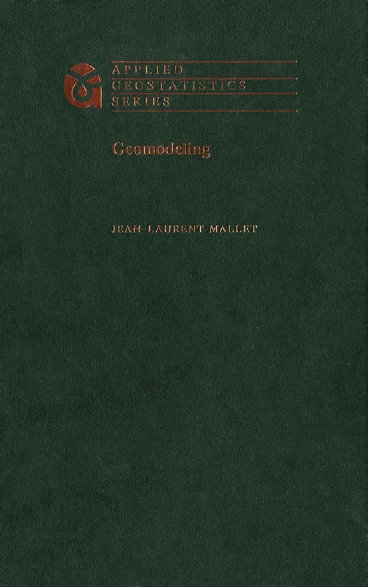
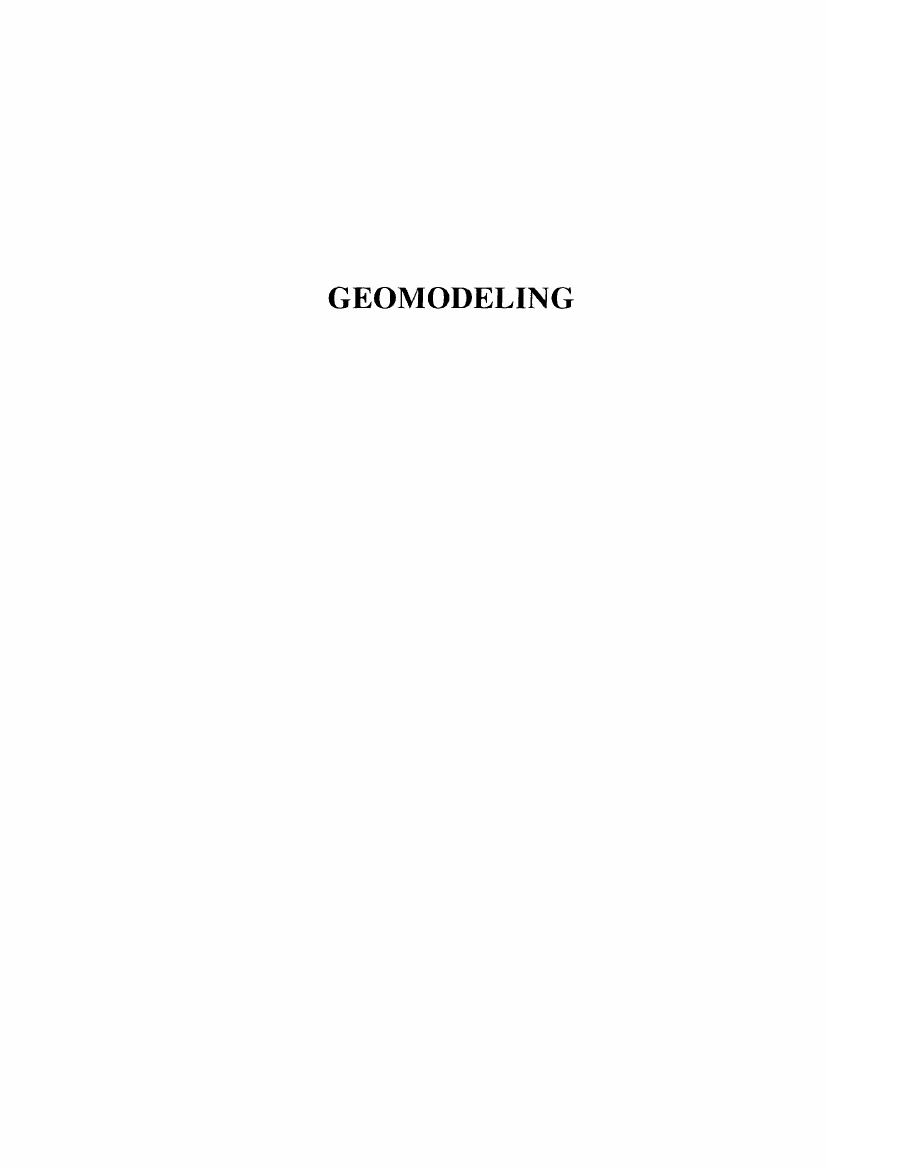
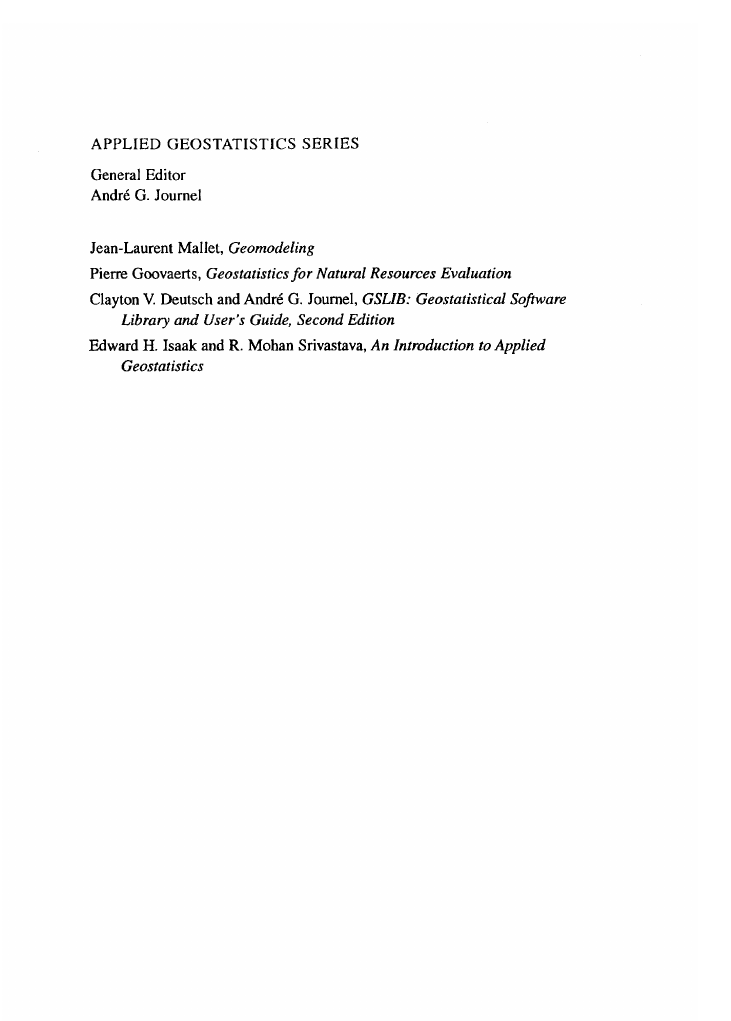
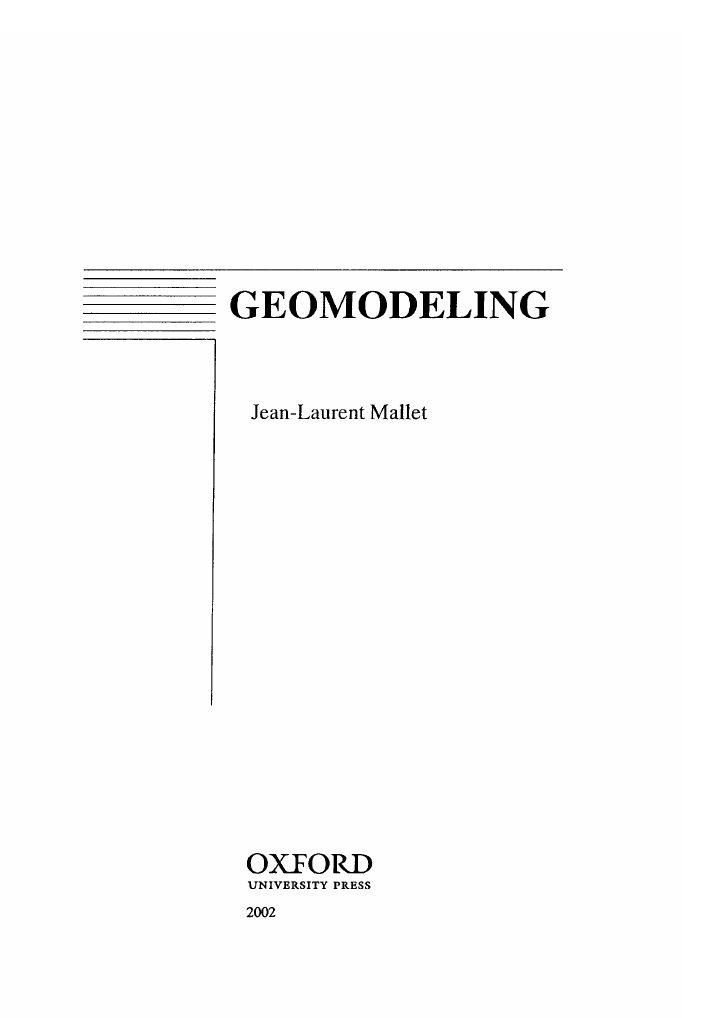
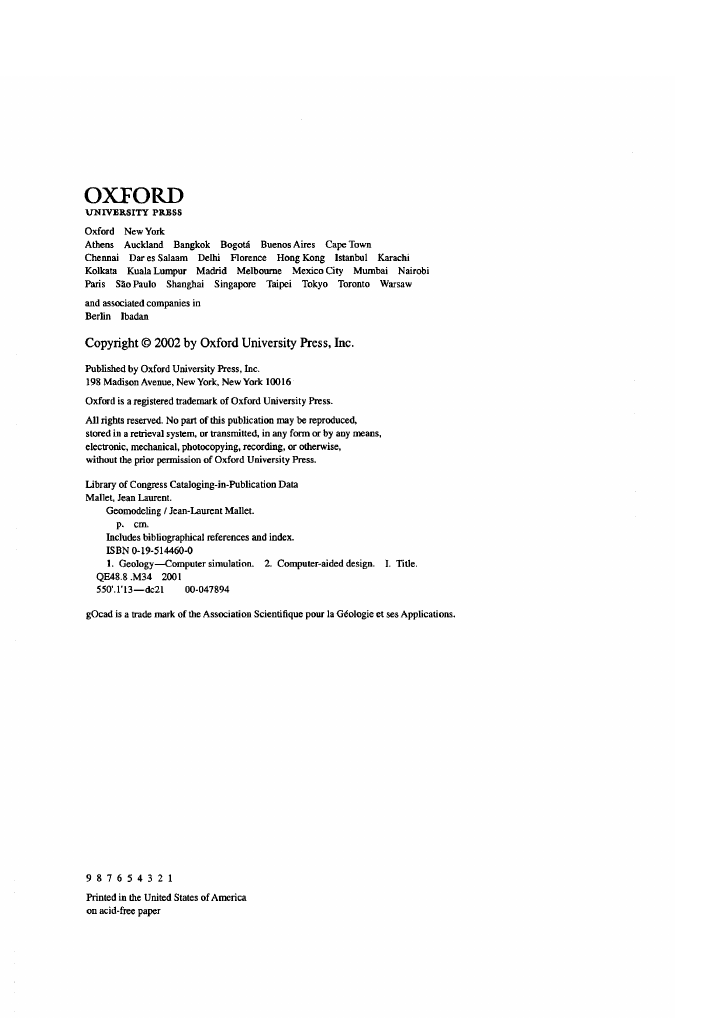
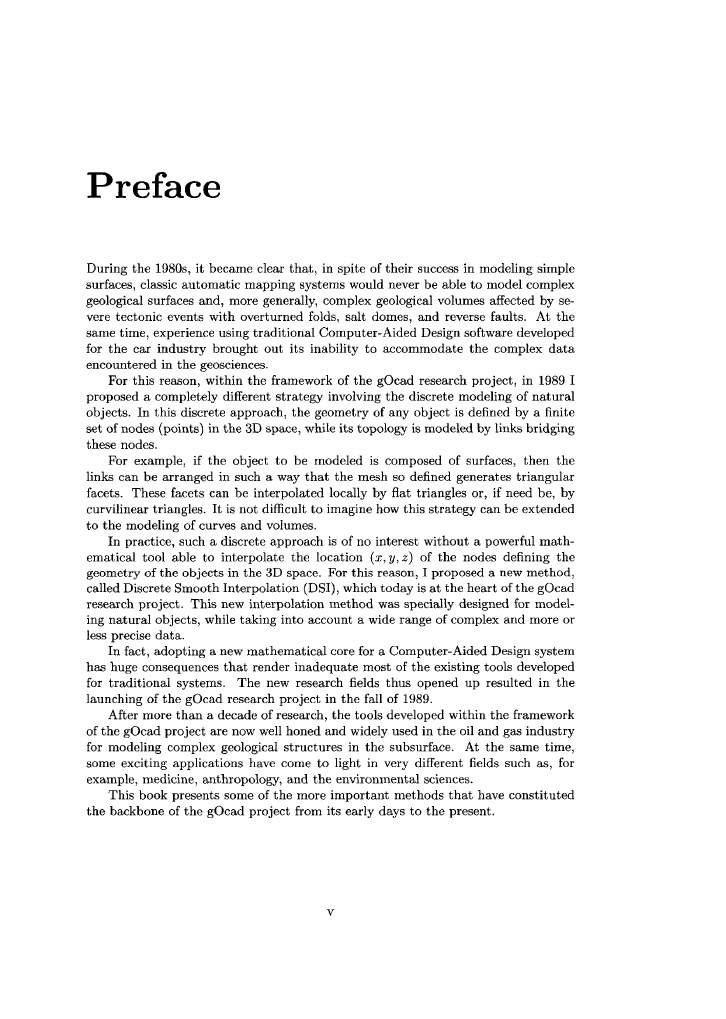
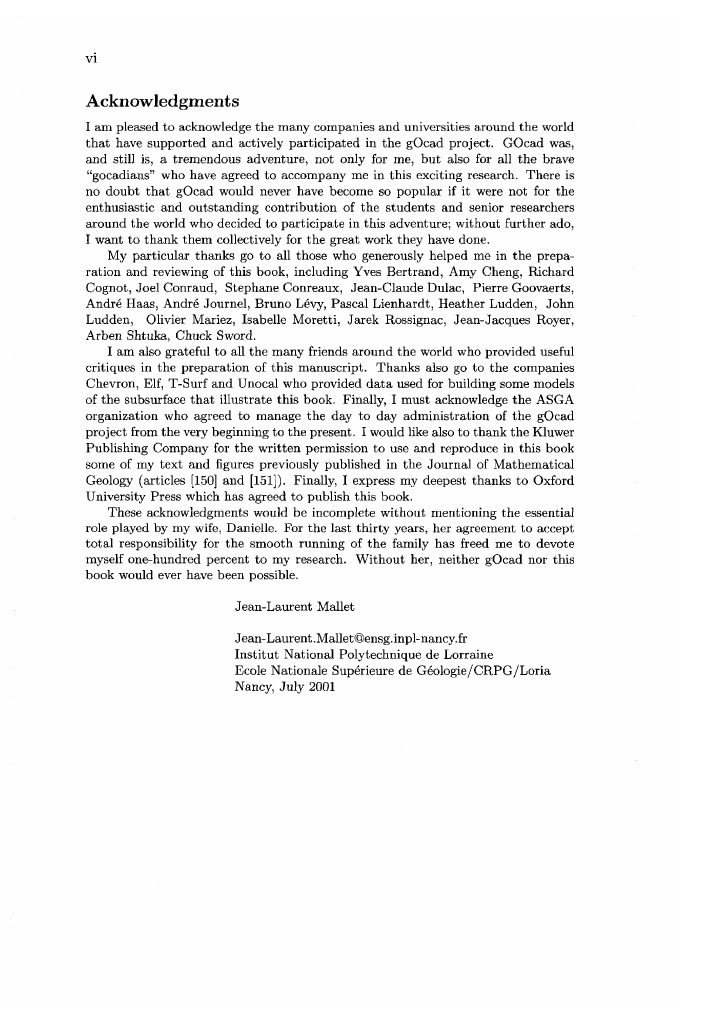
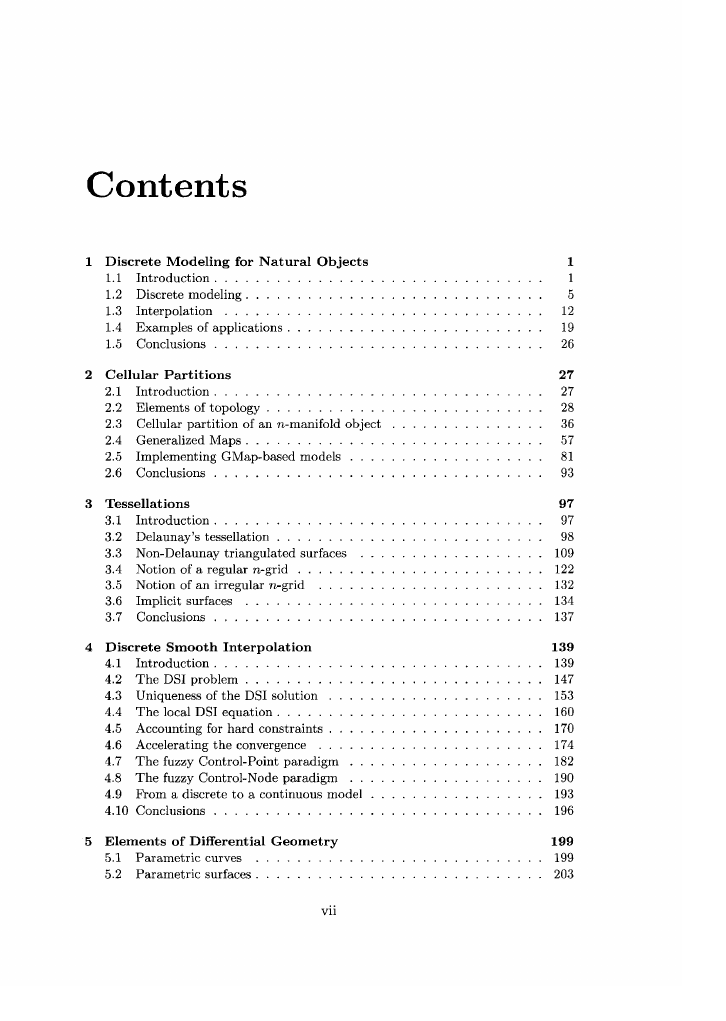








 2023年江西萍乡中考道德与法治真题及答案.doc
2023年江西萍乡中考道德与法治真题及答案.doc 2012年重庆南川中考生物真题及答案.doc
2012年重庆南川中考生物真题及答案.doc 2013年江西师范大学地理学综合及文艺理论基础考研真题.doc
2013年江西师范大学地理学综合及文艺理论基础考研真题.doc 2020年四川甘孜小升初语文真题及答案I卷.doc
2020年四川甘孜小升初语文真题及答案I卷.doc 2020年注册岩土工程师专业基础考试真题及答案.doc
2020年注册岩土工程师专业基础考试真题及答案.doc 2023-2024学年福建省厦门市九年级上学期数学月考试题及答案.doc
2023-2024学年福建省厦门市九年级上学期数学月考试题及答案.doc 2021-2022学年辽宁省沈阳市大东区九年级上学期语文期末试题及答案.doc
2021-2022学年辽宁省沈阳市大东区九年级上学期语文期末试题及答案.doc 2022-2023学年北京东城区初三第一学期物理期末试卷及答案.doc
2022-2023学年北京东城区初三第一学期物理期末试卷及答案.doc 2018上半年江西教师资格初中地理学科知识与教学能力真题及答案.doc
2018上半年江西教师资格初中地理学科知识与教学能力真题及答案.doc 2012年河北国家公务员申论考试真题及答案-省级.doc
2012年河北国家公务员申论考试真题及答案-省级.doc 2020-2021学年江苏省扬州市江都区邵樊片九年级上学期数学第一次质量检测试题及答案.doc
2020-2021学年江苏省扬州市江都区邵樊片九年级上学期数学第一次质量检测试题及答案.doc 2022下半年黑龙江教师资格证中学综合素质真题及答案.doc
2022下半年黑龙江教师资格证中学综合素质真题及答案.doc